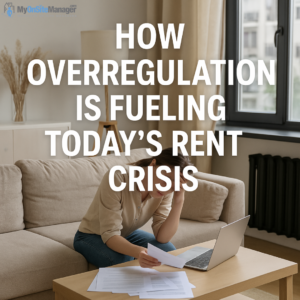 Why Are Rents So High? The Answer Might Be in the Rulebook
Why Are Rents So High? The Answer Might Be in the Rulebook
As renters across the U.S. continue to struggle with soaring housing costs, many look to inflation, interest rates, and supply shortages as the main culprits. While these factors certainly contribute to the affordability crisis, a growing body of research is shedding light on another, often overlooked force: overregulation.
A recent study published by MetroSight, and backed by the National Apartment Association and the National Multifamily Housing Council, digs deep into the regulatory landscape. The results are eye-opening: excessive local and state regulations are quietly pushing rents higher by driving up operating costs, delaying construction, and deterring housing investment.
A First-of-Its-Kind Study on Housing Regulation
What sets this research apart is its scale and scope. It analyzed over 600,000 rental units across 50 of the largest U.S. metropolitan areas, looking at data from 2004 to 2019. The findings highlight how an increase in regulatory burdens—ranging from permit delays to costly compliance mandates—correlates with rising rent levels.
The study also measures how these regulatory pressures translate into real-world business costs and how those costs are inevitably passed on to tenants.
The Three Major Ways Overregulation Drives Up Rent
1. Escalating Operating Costs
Every additional regulation—whether it’s environmental compliance, mandatory inspections, or tenant protection mandates—comes with a price. These costs add up quickly for property managers and landlords.
-
Administrative costs (paperwork, inspections, compliance staff)
-
Delayed repairs and renovations due to lengthy approval processes
-
Increased legal liability requiring expensive risk mitigation
When landlords are forced to absorb these costs, they adjust rents to protect their bottom line.
2. Longer Vacancy Periods and Lost Income
Strict regulations often limit a landlord’s flexibility. In many cities, even something as routine as repainting or switching flooring can require special permits or lengthy approval. This slows down the unit turnover process.
The result? Longer vacancies, lower income, and higher rents to make up for the loss.
3. Deterring New Development
Perhaps the most damaging impact of overregulation is its effect on new housing supply. Developers must navigate:
-
Complex zoning laws
-
Mandatory affordable housing units
-
Ever-changing building codes
-
Community pushback and NIMBYism
All of these can delay or even halt new projects. With fewer new units coming online, existing rentals grow more competitive—giving landlords more leverage to raise prices.
The Cost Spiral: A Vicious Cycle
Overregulation doesn’t just increase expenses—it creates a chain reaction that keeps housing unaffordable.
-
Increased regulations raise costs for developers and landlords
-
Those costs are shifted to renters through higher monthly rents
-
Fewer new properties are built, tightening the housing supply
-
As demand outweighs supply, prices surge again
Unless this cycle is disrupted, rent affordability will remain out of reach for many Americans.
Rethinking Policy: Is There a Middle Ground?
The article doesn’t advocate for eliminating regulations altogether—after all, rules exist to protect health, safety, and tenants’ rights. But the message is clear: balance is crucial.
Instead of rigid, one-size-fits-all laws, policymakers are encouraged to:
-
Streamline permitting processes to reduce delays
-
Reevaluate zoning restrictions that prevent high-density housing
-
Incentivize development through tax credits or grants
-
Implement flexible affordable housing mandates that work with market realities
The goal should be to foster a healthy rental market that protects both tenants and landlords—without stifling growth.
What This Means for Renters and Property Managers
If you’re a renter, understanding the hidden forces behind rising rent gives you better insight into the challenges your landlord may be facing. If you’re a property manager, it emphasizes the importance of advocating for smarter policies that make housing more accessible, not less.
Final Thoughts
Affordable housing isn’t just about capping rent—it’s about removing barriers to build, manage, and maintain housing efficiently. This new research highlights how overregulation—while well-intentioned—often backfires, making housing harder to find and even harder to afford.
For real solutions, policymakers need to look beyond the usual suspects and tackle the regulatory red tape that’s quietly choking America’s rental market.
Read the full source article here:
https://www.renocompanies.com/blogs/behind-the-high-cost-of-rent-how-overregulation-is-making-housing-less-affordable
